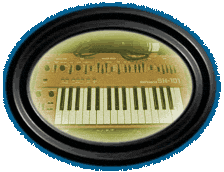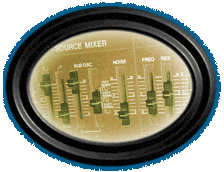Roland SH-101
The SH-101 should have been a well-deserving success for Roland when
it was introduced in the beginning of the eighties. After a row of more
or less odd mono synths, the company here seems to have taken a good look
at what worked and what didn't in the earlier models, collected the most
important features, designed the package with user-friendliness in mind
and finally added some technological tidbits such as arpeggiator and sequencer.
 Furthermore, the instrument is made of plastic,
can be run off batteries and can be slung-on with a strap, allowing the
flashy synth player to compete with the lead guitarists on stage. There's
even a special handle with pitch bend and modulation controls for this purpose.
To top it off, the SH-101 came in different colors (grey, red and blue).
SHotQ's SH-101 (known as "Rolle") is red.
Furthermore, the instrument is made of plastic,
can be run off batteries and can be slung-on with a strap, allowing the
flashy synth player to compete with the lead guitarists on stage. There's
even a special handle with pitch bend and modulation controls for this purpose.
To top it off, the SH-101 came in different colors (grey, red and blue).
SHotQ's SH-101 (known as "Rolle") is red.
Despite the commercial approach, we have to point out that this is a very flexible synth. The fact is that the Hotsynth Quintet can still be baffled by the huge range of different sounds that can be produced by the little red fella. Still, even though the plethora of sounds is vaste, the basic sound quality may not be the best - Rolle has a tendency to sound a bit grainy, and both oscillators and filters sound more nasty than beautiful. Not necessarily a bad point though!
Rolle is a single-VCO synth, with a 24 db/octave low pass filter, an ADSR envelope and an LFO. From this rather simple setup, Roland has made the most: The Oscillator has an octave switch for 16' - 2' (one octave less than the predecessor SH-09 that is, this is however compensated and improved by the octave switch for the keyboard - see below). Then, we have a slider for adjusting the amount of LFO modulation of pitch. The Oscillator can produce sawtooth and pulse wave. with pulse width variable manually, by the LFO or by the envelope. A mixer section allows you to blend sawtooth, pulse, suboscillator (square/pulse, one or two octaves down) and noise. However, there's no external signal input like on the SH-09 (originally, that is; our Rolle is modified with such an input by Beskberg).
The signal from the mixer section goes to the filter, which has fairly normal controls (cutoff, resonance, envelope and LFO mod amounts and keyboard tracking). Unfortunately no inverted envelope response. The ADSR envelope is used for both filter and amplitude, but there is a gate switch for the VCA as usual. The envelope can be single or multi triggered, or triggered by the LFO.
The LFO has a selector for triangle wave, square wave, random or noise (the latter is very useful for dirty sounds) and a rate slider. LFO delay is one of the features left out since the SH-09.
 To the left of the two and a half octave keyboard
you find a Performance section with the following parameters: A pitch bend
lever with the now-standard Roland feature for adding vibrato by pushing
the lever forward. The amount of bend (pitch and/or filter) and vibrato
can be set. It's worth noting that this vibrato is "independent"
of the LFO modulation you set for the VCO (the rate is the same though -
it's the same LFO). This means you can use random of noise modulation and
still get the standard vibrato (always sine wave). Furthermore there are
settings for portamento, including auto mode where portamento is activated
on legato play only. Finally volume and an octave transpose switch. This
transposes the keyboard, not the VCO, which is very well thought out and
implemented.
To the left of the two and a half octave keyboard
you find a Performance section with the following parameters: A pitch bend
lever with the now-standard Roland feature for adding vibrato by pushing
the lever forward. The amount of bend (pitch and/or filter) and vibrato
can be set. It's worth noting that this vibrato is "independent"
of the LFO modulation you set for the VCO (the rate is the same though -
it's the same LFO). This means you can use random of noise modulation and
still get the standard vibrato (always sine wave). Furthermore there are
settings for portamento, including auto mode where portamento is activated
on legato play only. Finally volume and an octave transpose switch. This
transposes the keyboard, not the VCO, which is very well thought out and
implemented.
The SH-101 also has a 100-note step sequencer and an arpeggiator (up/down/u+d). Both these use the tempo of the LFO (but this can be replaced by an incoming trig signal). Tune knob, Hold button (good for arpeggio or drones) and a transpose function of the keyboard completes the panel. If you add transposition, octave switches for keyboard and oscillator, pitch bend and sub-oscillator, Rolle has a range of 11 octaves!
Rolle can send and receive CV/Gate. An unexpected use for this has been to have Rolle act as LFO (by means of the arpeggiator) for the Trident, which has no filter LFO but a CV input for filter modulation. We have also successfully used Rolle together with a borrowed Technosaurus Microcon module (Topzy).
SHotQ have used Rolle on almost every single song we've made, and it can still surprise us now and then. Actually, we could do with another one!